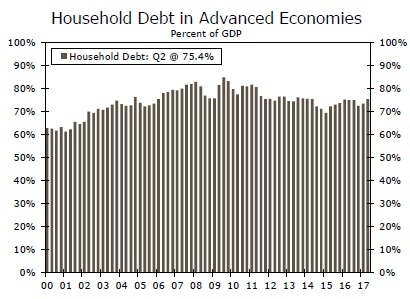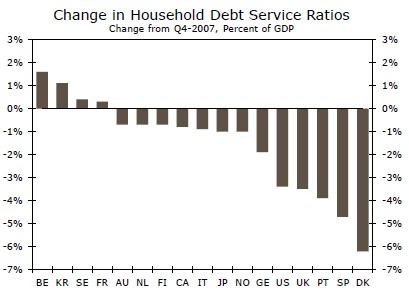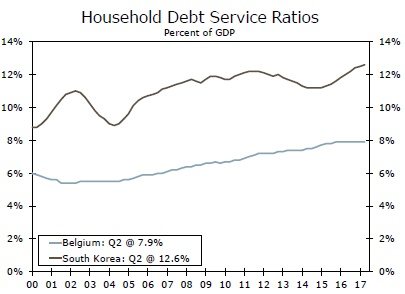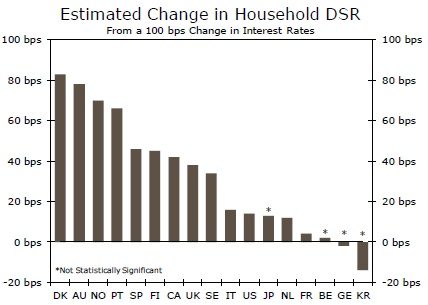Executive Summary
Some advanced economies have experienced increases in household leverage and household debt servicing ratios (DSR) in recent years. With many central banks beginning the process of normalizing their respective policy stances do these economies face a risk of stalling if debt servicing among households shoots higher? Could growth in the global economy be threatened again?
Our analysis suggests that any such concerns are probably premature. Some countries, notably Australia, Canada, Norway and Sweden face some risk of weaker growth in consumer spending due to higher debt servicing ratios for households. However, these four countries are hardly the most important economies in the world. In our view, household leverage seems to be a story for individual advanced economies rather than a systemic threat to the global economy.
Household Leverage Has Risen in Some Advanced Economies
As is widely known, a build-up in household debt, not only in the United States but in some other major economies as well, led to the global financial crisis of 2008. As shown in Figure 1, the household debt-to-GDP ratio among 17 advanced economies rose from about 60 percent at the turn of the century to more than 80 percent in 2008. The ratio has subsequently trended down to 75 percent, but progress among individual economies has been uneven.
Since its peak in early 2008, the ratio in the United States has receded by roughly 20 percentage points (Figure 2). The comparable ratio in Spain (SP), which experienced its own housing bubble a decade ago, has declined nearly as much as the American ratio. However, a number of countries have seen their household debt-to-GDP ratios rise over the past decade. The ratio in Norway (NO) rose to more than 100 percent in Q2-2017 from 73 percent in early 2008. Canada (CA), South Korea (KR) and Sweden (SE) have all experienced increases in their respective ratios of 20 percentage points or so over the past nine years. Ratios in Finland (FI), Australia (AU), Belgium (BE) and France (FR) have also risen markedly over that period.
This increase in household leverage in some of the advanced economies of the world over the past decade begs an interesting question: could the global economy be setting itself up for another recession due to excessive household debt? This question is especially pertinent now that many central banks are starting to remove policy accommodation. The Federal Reserve has led the pack with 125 bps of rate hikes over the past two years. However, other central banks are starting to tighten their own policy stances. Notably, the Bank of Canada has jacked up its main policy rate 75 bps since July, and the Bank of England lifted its bank rate 25 bps in November.
Not only could higher interest rates dent consumer spending via their depressing effect on interest rate-sensitive spending (i.e., automobiles and other durable goods), but rising debt-servicing costs could siphon off income that could otherwise be used for purchases of goods and services. Could these rate hikes, and potentially more to come, cause consumer spending to buckle in some advanced economies in the foreseeable future? Which countries would be most susceptible to weakness in consumer spending via higher interest rates?
How Sensitive Is Household Debt Service to Rising Rates?
Fortunately, the marked decline in interest rates since 2008 has given consumers in most advanced economies some breathing room in terms of lower DSRs.1 For example, the DSR in Denmark (DK) has dropped more than 6 percentage points since its peak in 2008 (Figure 3). Not only did monetary easing reduce Danish interest rates—the National Bank of Denmark cut its discount rate 450 bps between November 2008 and July 2012—but Danish households have de-leveraged somewhat over the past decade (Figure 2). The same dynamics (i.e., monetary easing and household de-leveraging) led to a 3.4 percentage point decline in the household DSR in the United States.
However, some countries have experienced an increase in their household DSR. Specifically, the DSR in South Korea (KR) has risen by more than 1 percentage point since 2008, and the comparable ratio in Belgium (BE) is up nearly 2 percentage points over that period. Household DSRs in Korea and Belgium currently stand at their highest levels since at least 2000 (Figure 4). Sweden (SE) and France (FR) have also seen increases in their respective DSRs since 2008.
To ascertain which economies may be the most susceptible to rising DSRs from higher interest rates, we performed econometric regressions for the 17 advanced economies in our sample.2 Our regression results are portrayed in Figure 5, and they show how much the DSR in each country responds over four quarters to an increase of 100 bps in interest rates. Denmark (DK), where we estimate that the DSR increases 83 bps after interest rates rise 100 bps, has the most sensitivity among the 17 countries in our sample to changes in interest rates. Denmark is followed closely by Australia (AU), Norway (NO) and Portugal (PT) in terms of the interest rate sensitivity of their DSRs. In contrast, the United States has a relatively low sensitivity, with the household DSR rising only 14 bps when interest rates increase 100 bps.
The high interest rate sensitivity of household DSRs in the aforementioned countries makes intuitive sense because the vast majority of household debt in these economies has variable rate structures.3 In contrast, American households have low interest rate sensitivity because most mortgages, which account for two-thirds of household debt in the United States, have fixed-rate structures.
Which Countries Are Most at Risk to Rising Rates?
Based on Figures 2, 3 and 5, Sweden (SE) seems to be the country that is most at risk to a rising interest rate environment. Not only have households in Sweden become more leveraged in recent years, but the household DSR has trended higher and household debt in Sweden has a fair degree of sensitivity to rising interest rates. Other countries that stand out as potentially at risk include Australia (AU), Canada (CA), South Korea (KR), Norway (NO), Belgium (BE) and France (FR). Each of these economies has some combination of increased household leverage, a rise in its DSR since 2008, or sensitivity to rising interest rates.
Let’s start with Belgium and France. Both countries have experienced increases in household leverage and household DSRs in recent years. However, our econometric results suggest that households in each country have low sensitivity to rising interest rates. Moreover, the European Central Bank is not likely to hike rates anytime soon.4 Consequently, we do not think that consumer spending in Belgium and France is at high risk of buckling due to crowding out by higher debt service, at least not in the foreseeable future.
Korea appears to be facing a bit more risk than Belgium and France. Like their Belgian and French counterparts, Korean households have increased their leverage and they have experienced a rise in their DSR. Furthermore, many analysts look for the Korean central bank to tighten modestly in coming quarters.5 That said, the Korean DSR appears to have low sensitivity to changes in interest rates, so the outlook for consumer spending in Korea does not seem to be threatened unduly by rising rates.
In our view, Australia, Canada Norway and Sweden face the highest risk of deceleration in consumer spending due to crowding out from higher debt service. In each of these economies, household leverage has risen in recent years due largely to the marked run-up in house prices that each country has experienced. In addition, the household DSR in each country has a fair to a high degree of sensitivity to rising rates, which appear to be headed higher in each country, if only slowly.6
Conclusion
At the beginning of this report, we mused about whether the global economy is setting itself up for another recession due to excessive household debt. In our view, any concerns regarding that potential seem to be premature. Yes, some countries, notably Australia, Canada, Norway and Sweden, face some risk of weaker growth in consumer spending due to higher debt servicing ratios for households. However, these four countries are hardly the most important economies in the world.
The financial position of households in the United States, the world’s largest economy, has improved significantly over the past 10 years and American household debt is not very sensitive to changes in interest rates. Japan and Germany, the third- and fourth-largest economies in the world, respectively, have also experienced reductions in household leverage and household DSRs in recent years. Furthermore, the Bank of Japan and the ECB likely will not be tightening their respective policy stances anytime soon. In sum, household leverage seems to be a story for individual advanced economies rather than a systemic threat to the global economy.
Recently, the stock market has experienced high levels of volatility. If you are thinking about participating in fast moving markets, please take the time to read the information below. Wells Fargo Investments, LLC will not be restricting trading on fast moving securities, but you should understand that there can be significant additional risks to trading in a fast market. We've tried to outline the issues so you can better understand the potential risks. If you're unsure about the risks of a fast market and how they may affect a particular trade you've considering, you may want to place your trade through a phone agent at 1-800-TRADERS. The agent can explain the difference between market and limit orders and answer any questions you may have about trading in volatile markets. Higher Margin Maintenance Requirements on Volatile Issues The wide swings in intra-day trading have also necessitated higher margin maintenance requirements for certain stocks, specifically Internet, e-commerce and high-tech issues. Due to their high volatility, some of these stocks will have an initial and a maintenance requirement of up to 70%. Stocks are added to this list daily based on market conditions. Please call 1-800-TRADERS to check whether a particular stock has a higher margin maintenance requirement. Please note: this higher margin requirement applies to both new purchases and current holdings. A change in the margin requirement for a current holding may result in a margin maintenance call on your account. Fast Markets A fast market is characterized by heavy trading and highly volatile prices. These markets are often the result of an imbalance of trade orders, for example: all "buys" and no "sells." Many kinds of events can trigger a fast market, for example a highly anticipated Initial Public Offering (IPO), an important company news announcement or an analyst recommendation. Remember, fast market conditions can affect your trades regardless of whether they are placed with an agent, over the internet or on a touch tone telephone system. In Fast Markets service response and account access times may vary due to market conditions, systems performance, and other factors. Potential Risks in a Fast Market "Real-time" Price Quotes May Not be Accurate Prices and trades move so quickly in a fast market that there can be significant price differences between the quotes you receive one moment and the next. Even "real-time quotes" can be far behind what is currently happening in the market. The size of a quote, meaning the number of shares available at a particular price, may change just as quickly. A real-time quote for a fast moving stock may be more indicative of what has already occurred in the market rather than the price you will receive. Your Execution Price and Orders Ahead In a fast market, orders are submitted to market makers and specialists at such a rapid pace, that a backlog builds up which can create significant delays. Market makers may execute orders manually or reduce size guarantees during periods of volatility. When you place a market order, your order is executed on a first-come first-serve basis. This means if there are orders ahead of yours, those orders will be executed first. The execution of orders ahead of yours can significantly affect your execution price. Your submitted market order cannot be changed or cancelled once the stock begins trading. Initial Public Offerings may be Volatile IPOs for some internet, e-commerce and high tech issues may be particularly volatile as they begin to trade in the secondary market. Customers should be aware that market orders for these new public companies are executed at the current market price, not the initial offering price. Market orders are executed fully and promptly, without regard to price and in a fast market this may result in an execution significantly different from the current price quoted for that security. Using a limit order can limit your risk of receiving an unexpected execution price. Large Orders in Fast Markets Large orders are often filled in smaller blocks. An order for 10,000 shares will sometimes be executed in two blocks of 5,000 shares each. In a fast market, when you place an order for 10,000 shares and the real-time market quote indicates there are 15,000 shares at 5, you would expect your order to execute at 5. In a fast market, with a backlog of orders, a real-time quote may not reflect the state of the market at the time your order is received by the market maker or specialist. Once the order is received, it is executed at the best prices available, depending on how many shares are offered at each price. Volatile markets may cause the market maker to reduce the size of guarantees. This could result in your large order being filled in unexpected smaller blocks and at significantly different prices. For example: an order for 10,000 shares could be filled as 2,500 shares at 5 and 7,500 shares at 10, even though you received a real-time quote indicating that 15,000 shares were available at 5. In this example, the market moved significantly from the time the "real-time" market quote was received and when the order was submitted. Online Trading and Duplicate Orders Because fast markets can cause significant delays in the execution of a trade, you may be tempted to cancel and resubmit your order. Please consider these delays before canceling or changing your market order, and then resubmitting it. There is a chance that your order may have already been executed, but due to delays at the exchange, not yet reported. When you cancel or change and then resubmit a market order in a fast market, you run the risk of having duplicate orders executed. Limit Orders Can Limit Risk A limit order establishes a "buy price" at the maximum you're willing to pay, or a "sell price" at the lowest you are willing to receive. Placing limit orders instead of market orders can reduce your risk of receiving an unexpected execution price. A limit order does not guarantee your order will be executed -" however, it does guarantee you will not pay a higher price than you expected. Telephone and Online Access During Volatile Markets During times of high market volatility, customers may experience delays with the Wells Fargo Online Brokerage web site or longer wait times when calling 1-800-TRADERS. It is possible that losses may be suffered due to difficulty in accessing accounts due to high internet traffic or extended wait times to speak to a telephone agent. Freeriding is Prohibited Freeriding is when you buy a security low and sell it high, during the same trading day, but use the proceeds of its sale to pay for the original purchase of the security. There is no prohibition against day trading, however you must avoid freeriding. To avoid freeriding, the funds for the original purchase of the security must come from a source other than the sale of the security. Freeriding violates Regulation T of the Federal Reserve Board concerning the extension of credit by the broker-dealer (Wells Fargo Investments, LLC) to its customers. The penalty requires that the customer's account be frozen for 90 days. Stop and Stop Limit Orders A stop is an order that becomes a market order once the security has traded through the stop price chosen. You are guaranteed to get an execution. For example, you place an order to buy at a stop of $50 which is above the current price of $45. If the price of the stock moves to or above the $50 stop price, the order becomes a market order and will execute at the current market price. Your trade will be executed above, below or at the $50 stop price. In a fast market, the execution price could be drastically different than the stop price. A "sell stop" is very similar. You own a stock with a current market price of $70 a share. You place a sell stop at $67. If the stock drops to $67 or less, the trade becomes a market order and your trade will be executed above, below or at the $67 stop price. In a fast market, the execution price could be drastically different than the stop price. A stop limit has two major differences from a stop order. With a stop limit, you are not guaranteed to get an execution. If you do get an execution on your trade, you are guaranteed to get your limit price or better. For example, you place an order to sell stock you own at a stop limit of $67. If the stock drops to $67 or less, the trade becomes a limit order and your trade will only be executed at $67 or better. Glossary All or None (AON) A stipulation of a buy or sell order which instructs the broker to either fill the whole order or don't fill it at all; but in the latter case, don't cancel it, as the broker would if the order were filled or killed. Day Order A buy or sell order that automatically expires if it is not executed during that trading session. Fill or Kill An order placed that must immediately be filled in its entirety or, if this is not possible, totally canceled. Good Til Canceled (GTC) An order to buy or sell which remains in effect until it is either executed or canceled (WellsTrade® accounts have set a limit of 60 days, after which we will automatically cancel the order). Immediate or Cancel An order condition that requires all or part of an order to be executed immediately. The part of the order that cannot be executed immediately is canceled. Limit Order An order to buy or sell a stated quantity of a security at a specified price or at a better price (higher for sales or lower for purchases). Maintenance Call A call from a broker demanding the deposit of cash or marginable securities to satisfy Regulation T requirements and/or the House Maintenance Requirement. This may happen when the customer's margin account balance falls below the minimum requirements due to market fluctuations or other activity. Margin Requirement Minimum amount that a client must deposit in the form of cash or eligible securities in a margin account as spelled out in Regulation T of the Federal Reserve Board. Reg. T requires a minimum of $2,000 or 50% of the purchase price of eligible securities bought on margin or 50% of the proceeds of short sales. Market Makers NASD member firms that buy and sell NASDAQ securities, at prices they display in NASDAQ, for their own account. There are currently over 500 firms that act as NASDAQ Market Makers. One of the major differences between the NASDAQ Stock Market and other major markets in the U.S. is NASDAQ's structure of competing Market Makers. Each Market Maker competes for customer order flow by displaying buy and sell quotations for a guaranteed number of shares. Once an order is received, the Market Maker will immediately purchase for or sell from its own inventory, or seek the other side of the trade until it is executed, often in a matter of seconds. Market Order An order to buy or sell a stated amount of a security at the best price available at the time the order is received in the trading marketplace. Specialists Specialist firms are those securities firms which hold seats on national securities exchanges and are charged with maintaining orderly markets in the securities in which they have exclusive franchises. They buy securities from investors who want to sell and sell when investors want to buy. Stop An order that becomes a market order once the security has traded through the designated stop price. Buy stops are entered above the current ask price. If the price moves to or above the stop price, the order becomes a market order and will be executed at the current market price. This price may be higher or lower than the stop price. Sell stops are entered below the current market price. If the price moves to or below the stop price, the order becomes a market order and will be executed at the current market price. Stop Limit An order that becomes a limit order once the security trades at the designated stop price. A stop limit order instructs a broker to buy or sell at a specific price or better, but only after a given stop price has been reached or passed. It is a combination of a stop order and a limit order. These articles are for information and education purposes only. You will need to evaluate the merits and risks associated with relying on any information provided. Although this article may provide information relating to approaches to investing or types of securities and investments you might buy or sell, Wells Fargo and its affiliates are not providing investment recommendations, advice, or endorsements. Data have been obtained from what are considered to be reliable sources; however, their accuracy, completeness, or reliability cannot be guaranteed. Wells Fargo makes no warranties and bears no liability for your use of this information. The information made available to you is not intended, and should not be construed as legal, tax, or investment advice, or a legal opinion.
Recommended Content
Editors’ Picks
EUR/USD edges lower toward 1.0700 post-US PCE

EUR/USD stays under modest bearish pressure but manages to hold above 1.0700 in the American session on Friday. The US Dollar (USD) gathers strength against its rivals after the stronger-than-forecast PCE inflation data, not allowing the pair to gain traction.
GBP/USD retreats to 1.2500 on renewed USD strength

GBP/USD lost its traction and turned negative on the day near 1.2500. Following the stronger-than-expected PCE inflation readings from the US, the USD stays resilient and makes it difficult for the pair to gather recovery momentum.
Gold struggles to hold above $2,350 following US inflation

Gold turned south and declined toward $2,340, erasing a large portion of its daily gains, as the USD benefited from PCE inflation data. The benchmark 10-year US yield, however, stays in negative territory and helps XAU/USD limit its losses.
Bitcoin Weekly Forecast: BTC’s next breakout could propel it to $80,000 Premium

Bitcoin’s recent price consolidation could be nearing its end as technical indicators and on-chain metrics suggest a potential upward breakout. However, this move would not be straightforward and could punish impatient investors.
Week ahead – Hawkish risk as Fed and NFP on tap, Eurozone data eyed too

Fed meets on Wednesday as US inflation stays elevated. Will Friday’s jobs report bring relief or more angst for the markets? Eurozone flash GDP and CPI numbers in focus for the Euro.




